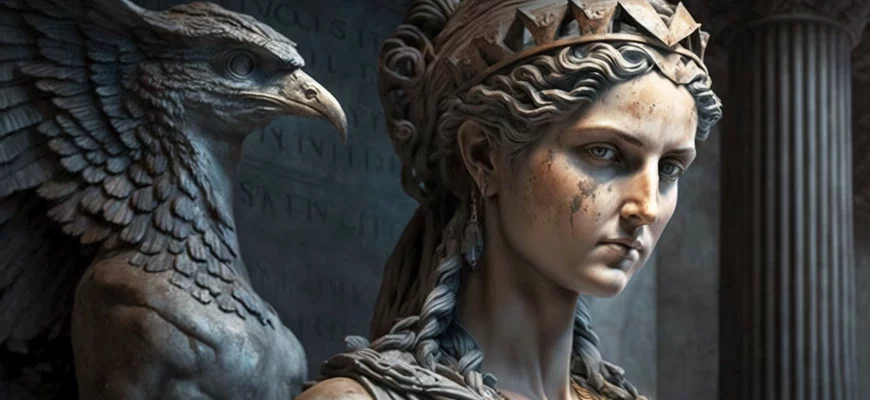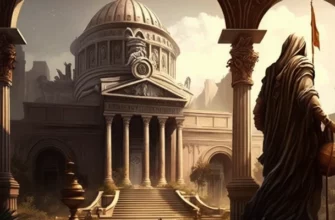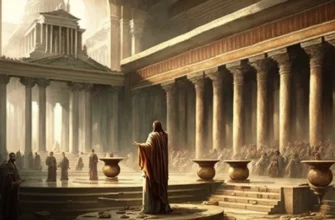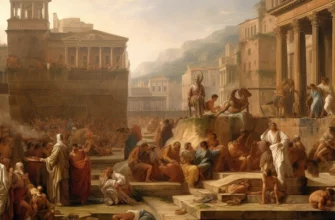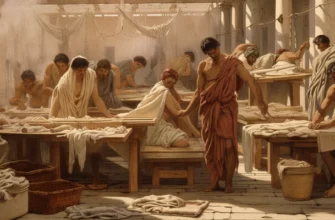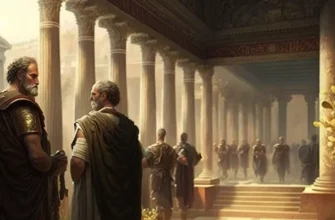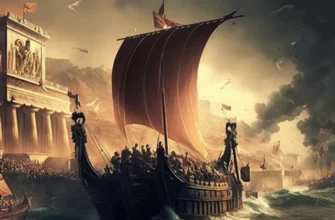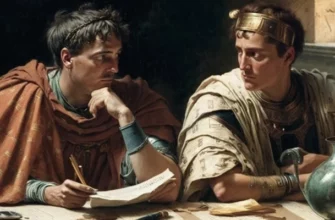Ancient Roman art is one of the most famous and influential art cultures in the world. Roman art developed over many centuries, from the early Republic to the Empire. It reflected all aspects of Roman life, from political power and religion to everyday life and entertainment. Roman art was also influential in world history, as its style and techniques influenced the art of Europe and the Middle East for centuries. In this article, we will look at the development of Roman art, its types, the influence of Greek art on it, its role in Roman society, and its legacy after the fall of the Roman Empire.
- The development of art in Roman culture
- Types of art in Ancient Rome
- Architecture
- Sculpture
- Painting
- Decorative arts
- Music and dance
- Portrait sculpture
- Decorative sculpture
- Roman painting
- Art as a means of propaganda
- Art as a symbol of status
- Art as a means of religious expression
- Decline of art after the fall of the Roman Empire
- Conclusions
The development of art in Roman culture
The art of Ancient Rome developed over the more than thousand-year history of Roman civilization, which went through periods of republic, empire, and the fall of Rome. In the early centuries of Roman history, the development of art was strongly influenced by the Etruscans and Greeks. However, over time, Roman art began to develop in its own direction with its own style and techniques.
One of the most important aspects of the development of art in Roman culture was its functionality. The Romans created art that not only had a decorative function but also conveyed important informational, political, and religious messages. For example, many Roman sculptures were designed to reflect the power of the emperors, while mosaics and frescoes on the walls of buildings conveyed various stories and myths.
Roman art was diverse and included various types, such as architecture, sculpture, and painting. These art forms were often combined with each other, for example, in the decoration of various buildings.
In the following sections, we will look at the different types of art in Ancient Rome and their characteristics.
Types of art in Ancient Rome
The art of Ancient Rome included various types of art that differed in style and technique. The main types of art in Ancient Rome were architecture, sculpture, and painting.
Architecture
Architecture was one of the most important types of art in Roman culture. Roman architects created complex and majestic buildings such as amphitheaters, theaters, temples, and basilicas. One of the most famous examples of Roman architecture is the Colosseum, which was built in the 80s of the first century AD. Roman buildings differed from Greek ones in their grandeur and use of arching techniques.
Sculpture
Sculpture was another important art form in Ancient Rome. Roman sculptures were often designed to reflect the power of emperors and military heroes. One of the most famous examples of Roman sculpture is “Augustus in Arms,” located in the Vatican. Roman sculptures differed from Greek ones in their more realistic depiction of the human figure and their use of reliefs.
Painting
Painting was also an important art form in Ancient Rome. The Romans used various techniques, such as frescoes and mosaics, to create images on the walls of buildings. One of the most famous examples of Roman painting is Hadrian’s Villa in Tivoli, where the walls were decorated with frescoes depicting landscapes, animals, and mythological scenes. Roman painting differed from Greek painting in its more realistic technique and use of bright colors.
Decorative arts
Other types of art in ancient Rome included decorative arts, which involved the creation of mosaics, ceramics, and glass. Roman craftsmen used complex techniques to create sophisticated and elegant decorative artworks, which often adorned buildings and household items.
Music and dance
Music and dance also played an important role in Roman life and culture. The Romans used various musical instruments, such as flutes and lutes, and staged various dances and performances. Such events were often associated with religious rituals and holidays.
In general, the art of Ancient Rome reflected the richness and diversity of Roman culture. Its forms and styles played an important role in shaping the cultural identity and heritage of the Romans, which continues to be an important source for the study of history and art to this day.
Portrait sculpture
Portrait sculpture was very important in Ancient Rome, as images of famous people ensured their immortality and immortization in culture. Portraits were popular in Roman sculpture and depicted people of different social statuses and ages.
Portrait sculpture began to develop in Roman art in the second half of the 2nd century BC and grew in popularity over the following centuries. Roman portraits often differed from Greek ones in their realism and detail, as well as the expressiveness of the depicted face.
Roman sculptors used various techniques and materials to create portraits. Sculptures were made of marble, bronze, clay, and other materials. Roman sculptors possessed a high level of skill and used complex techniques such as relief, deep carving, and patination.
Portraits served various functions in Roman society. They were used as symbols of power and wealth, as well as a means of preserving the memory of famous people. Portraits of emperors and military heroes were placed in squares and buildings to demonstrate their power and abilities.
Decorative sculpture
Decorative sculpture in ancient Rome was used to adorn many buildings and squares, as well as to create monumental monuments. Roman sculptors created complex compositions depicting historical events, mythological scenes, and the animal and plant world.
Decorative sculpture was made from various materials, including marble, bronze, clay, and stone. Sculptors used various techniques, such as relief, deep carving, and bronze casting. These techniques allowed them to create complex shapes and details that reflected the wealth and luxury of Roman culture.
Decorative sculpture had various functions in Roman society. It served to decorate many buildings and squares, as well as to create monumental monuments. Historical events and mythological scenes were depicted in sculptures to show the power, glory, and cultural values of Roman society.
Many famous sculptures were created in Ancient Rome, depicting various scenes and characters. One of the most famous decorative sculptures is “Laocoön and His Sons,” which depicts the Greek myth of Laocoön and his sons, who were killed by snakes. Another famous sculpture is “Apollo Belvedere,” which depicts the Greek god Apollo in the style of the artist Phidias.
Also among the famous sculptures of Ancient Rome is “David,” which depicts the biblical hero David defeating the giant Goliath. This sculpture became a symbol of the Renaissance and one of the most famous works of art in the world.
Decorative sculpture in Ancient Rome had a significant influence on Renaissance art. Renaissance artists revived classical styles and techniques, using them to create new works of art. Famous sculptors such as Michelangelo and Donatello were greatly influenced by Roman sculptors and their work.
Decorative sculpture in Ancient Rome is an important artifact that reflects the wealth and luxury of Roman culture. It had a great influence on Renaissance art and became a symbol of classical beauty and harmony. Roman sculptors left behind many incredible works of art that still captivate with their beauty and diversity.
Roman painting
Roman painting developed throughout the history of Ancient Rome, but almost none of it has survived to the present day. According to historians, the first examples of Roman painting began to appear at the beginning of the 2nd century BC. They differed from Greek painting in that the Romans actively used the fresco technique, which allowed them to create large compositions on the walls of buildings.
One of the most important aspects of Roman painting was technique. The Romans used the fresco technique, which consisted of applying paint to fresh plaster. This allowed the walls of buildings to become part of the artwork.
In terms of style, Roman painting was very diverse and eclectic, combining elements of Greek and Roman art, as well as using themes from different cultures and traditions.
Roman painting reflected a variety of themes and genres. In particular, a popular genre was portraiture, which depicted famous people such as emperors, warriors, and noble citizens. Mythological and religious subjects, landscapes, and architectural structures were also popular.
Roman painting had a great influence on European art in later centuries. For example, in medieval Europe, Roman frescoes served as an important source of inspiration for the Christian artistic tradition. Elements of Roman painting can also be found in Renaissance art, particularly in the works of such famous masters as Raphael Santi and Michelangelo.
Today, only a very limited number of examples of Roman painting have survived. The most famous of these are the frescoes from Pompeii and Herculaneum, which were discovered during excavations in the 19th century. These frescoes give us an idea of the technique and style of Roman painting, as well as their themes and genres.
The frescoes from Pompeii date back to the 1st century BC and depict a variety of themes, such as mythology, landscapes, and the lives of ordinary people. Their distinctive features are their bright colors and three-dimensional rendering.
The frescoes from Herculaneum, which were found in the homes of wealthy Romans, depict images of noble persons, mythological scenes, and the lives of ordinary people. They date back to the 1st century BC and differ in technique from the frescoes of Pompeii, namely, they were executed using the “a secco” technique, which consisted of applying paint to already dry plaster.
Art as a means of propaganda
In ancient Rome, art not only depicted and reproduced the beauty of the world, but was also used as a means of propagating political and social ideology. This was especially important during the Republic and the Empire.
The propaganda goals of art were evident in the construction of public buildings and monuments. Roman emperors used art to immortalize their reign and portray themselves as powerful and famous leaders. For example, the founder of Rome, Romulus, was imagined as a deity, and the myth about him was conveyed through sculpture, paintings, and other forms of art.
Emperors also sponsored the construction of buildings and temples to honor their ancestors and preserve the memory of their reign. For example, Vespasian built the Colosseum, which became a symbol of the power and strength of the Roman Empire. In turn, Augustus built the Baths of Caracalla, which were not only a sports center but also a venue for cultural events and religious ceremonies.
Art was also a means of ensuring social legitimacy. This was manifested in images of emperors and their families, which were presented in various forms of art, emphasizing their power and importance. Such images strengthened the imperial cult and helped to maintain power.
To reinforce their authority and legitimacy, Roman emperors used art as a means of propaganda. One striking example of this is the Arch of Titus, which was built in honor of Titus’ victory over the Jews.
The frescoes and mosaics depicted scenes from the lives of emperors, their relatives and associates, military exploits, as well as scenes from Roman mythology and history. Such images not only glorified the emperors and their dynasty, but also supported a certain moral and ethical position in society.
In addition, art was used as a means of propaganda for Roman ideology and religion. For example, mosaics and frescoes depicted scenes from religious rituals and deities that corresponded to Roman religious ideology. This contributed to the spread of Roman culture and its acceptance in various countries conquered by the Roman Empire.
Thus, art in Ancient Rome played an important role in shaping and maintaining the cultural identity of Roman society. It not only decorated cities and buildings, but also had a great influence on the moral and ethical development of society, as well as its ideology and religion.
Art as a symbol of status
In Ancient Rome, art was also used as a symbol of status and social position. The Romans were interested in the flourishing of their art and, therefore, in enriching their homes and other buildings with elements of art, such as sculptures and paintings.
For example, Roman patricians, wealthy people, commissioned sculptures with their image to demonstrate their power and influence in society. Such portraits could be placed in public places, such as forums and pools, which were visited by rich and influential people.
Roman architecture and sculpture also used many elements that symbolized power and wealth. For example, the capitals of columns in buildings were often decorated with images of leaves and animals, which were a kind of symbol of wealth and status.
In addition, other materials such as gold, marble, and stone were also used in construction and paintings to emphasize the status and wealth of the owner. Most Roman houses were decorated with various types of art, such as sculptures and paintings, to demonstrate their status and taste.
Thus, art in Roman society was used as a means of expressing power and wealth. It was an important part of Roman culture, reflecting the status and social position of people in society.
Art as a means of religious expression
Art in ancient Rome played an important role in religious life, which was manifested in the creation of various works of art that expressed religious ideas and symbols.
One of the most famous examples of religious sculpture in Ancient Rome is the sculpture of the god Jupiter, located on Capitoline Hill in Rome. This majestic work of art depicts the god Jupiter sitting on a throne, holding a lightning bolt in his left hand and blessing with his right hand.
Roman mosaic art was also widely used to express religious ideas. For example, the Chapel of San Lorenzo in Rome houses a mosaic of Christ Pantocrator, dating from the 5th century. This mosaic depicts Jesus Christ as the ruler of the whole world, sitting majestically on a throne, holding the Book of Life in his left hand and raising his right hand in a gesture of blessing.
The art of relief was also widespread in Roman culture and was also used to express religious ideas. For example, the relief on the Arch of Titus in Rome depicts the victory over the Jews and the bringing of conquered riches to Rome. In this relief, the soldiers clearly symbolize the Roman state, which defeated its enemies through its strength and greatness.
Decline of art after the fall of the Roman Empire
After the fall of the Roman Empire, the art of Ancient Rome experienced a significant decline. Some monuments have survived, but they were often destroyed or converted into Christian shrines.
In the Middle Ages, art was strongly influenced by the religious and philosophical attitudes of Christianity. Roman monuments became evidence for Christians of the fall of “pagan” culture and their powerful God who defeated Rome. A significant portion of Roman monuments were converted into Christian churches or used for the construction of new buildings.
However, over time, a new art form emerged, called the Romanesque style, which developed from early Christian and Byzantine art and also incorporated elements of Roman art.
Thus, the art of Ancient Rome, although it declined after the fall of the empire, continued to exist through its influence on the development of subsequent styles and cultures.
Conclusions
The art of Ancient Rome is of great importance to contemporary culture as a historical, cultural, and aesthetic heritage.
Its influence is reflected in architecture, sculpture, painting, and other art forms. Roman architecture, in particular, served as a model for many other cultures and styles, including the Renaissance, which originated in Italy in the 15th century. Majestic Roman buildings such as the Colosseum and the Pantheon have become icons of world architecture.
Portrait sculpture in Rome also made a significant contribution to world culture, creating idealized images of people and depicting important events such as victories and religious ceremonies.
In the modern world, the art of Ancient Rome can be found in museums and galleries around the world, where it serves as a source of inspiration for contemporary artists and designers.
Thus, the art of Ancient Rome plays an important role in our modern culture as a legacy of the past that continues to inspire and influence our creativity and perception of the world.
